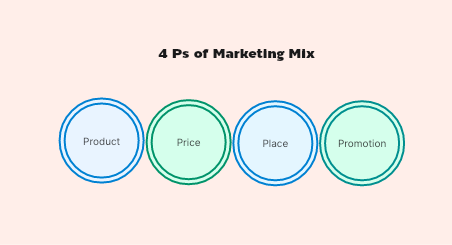In the dynamic realm of marketing, the 4 Ps of marketing mix—Product, Price, Place, and Promotion—serve as the foundational pillars for crafting effective strategies. Understanding these elements is paramount for businesses striving to make a mark in the competitive landscape. In this article, we delve into the definition, significance, and practical application of the 4 Ps, while introducing an innovative tool, Boardmix, to streamline the process.
Part 1. What Are 4 P’s of Marketing Mix?
The 4 Ps of marketing are commonly referred to as the "Marketing Mix." The concept of the Marketing Mix was introduced by Neil Borden in the 1950s and later popularized by E. Jerome McCarthy in his 1960 book "Basic Marketing: A Managerial Approach." The Marketing Mix is a foundational framework that helps businesses address key components of their marketing strategy, and the 4 Ps represent the critical elements: Product, Price, Place, and Promotion.
These 4 Ps serve as a framework for marketing decision-making and are crucial for developing a comprehensive and effective marketing strategy. They provide a structured approach for businesses to address key aspects of their product or service offerings, pricing, distribution, and promotional activities in the market.
Part 2. What Are the 4 P’s of Marketing Called?
The four elements encompass the various components involved in bringing a product or service to market. The 4 Ps of marketing are:
- Product: This refers to the tangible or intangible goods and services that a company offers to meet the needs and wants of its target customers. It involves decisions regarding product design, features, quality, branding, and packaging.
- Price: This involves setting the right price for the product or service, taking into account factors such as production costs, competitor pricing, and perceived value by the customers. Pricing strategies can vary, including penetration pricing, skimming pricing, and discount pricing.
- Place (Distribution): This relates to how the product or service is made available to the customers. It involves decisions about distribution channels, logistics, inventory management, and the overall strategy for getting the product to the target market. Distribution channels can include direct sales, retailers, online platforms, and more.
- Promotion: This involves the various ways a company communicates and promotes its products or services to the target audience. It includes advertising, public relations, sales promotions, personal selling, and other promotional activities. The goal is to create awareness, generate interest, and persuade customers to purchase the product or service.
Part 3. How Is the 4 P’s of Marketing Used?
The 4 Ps of marketing are used as a strategic framework to guide businesses in making decisions related to their marketing strategy. Here's how each of the 4 Ps is typically applied:
1. Product:
Product Development: Companies use market research to understand customer needs and preferences, leading to the creation or improvement of products that meet those needs.
Branding: Developing and maintaining a strong brand identity is crucial. This involves decisions about logos, packaging, product features, and overall brand image.
2. Price:
Pricing Strategies: Businesses set prices that align with their overall business goals. This may involve strategies like penetration pricing (setting a low initial price to gain market share) or skimming pricing (setting a high initial price and gradually lowering it).
3. Place (Distribution):
Channel Selection: Deciding on the most effective distribution channels to reach the target market, whether through direct sales, retailers, online platforms, or a combination of these.
Logistics and Supply Chain Management: Ensuring that products are efficiently and effectively delivered to the right locations at the right time.
4. Promotion:
Advertising: Creating and implementing advertising campaigns to build awareness and communicate the value proposition of the product or service.
Sales Promotion: Using tactics like discounts, coupons, or promotions to stimulate sales.
Public Relations: Managing the company's public image through media relations, events, and other PR activities.
Personal Selling: Direct interaction between sales representatives and potential customers to persuade them to buy.
By carefully considering and optimizing each of the 4 Ps, businesses can create a comprehensive marketing strategy. This strategy helps ensure that the product or service meets customer needs, is priced appropriately, is available where and when customers want it, and is effectively promoted to the target audience. The 4 Ps provide a structured approach to marketing decision-making, allowing businesses to adapt their strategies to changing market conditions and customer preferences.
Part 4. How to Write the 4 P’s of Marketing
When writing the 4 Ps of marketing for a specific product or service, it involves detailing the strategies and decisions related to each element of the marketing mix. Here's a step-by-step guide on how to write the 4 Ps:
1. Product:
Product Description: Provide a detailed description of the product or service. Highlight its features, benefits, and any unique selling points.
Brand Strategy: Discuss the branding strategy, including the brand identity, positioning, and how the product stands out in the market.
Product Lifecycle: Consider where the product is in its lifecycle—introduction, growth, maturity, or decline—and tailor strategies accordingly.
2. Price:
Pricing Objectives: Clearly define the pricing objectives, whether it's maximizing profits, gaining market share, or positioning the product as a premium offering.
Pricing Strategy: Outline the chosen pricing strategy, such as cost-plus pricing, value-based pricing, or competitive pricing.
Discounts and Promotions: Specify any discounts, promotional pricing, or bundling strategies that will be employed.
3. Place (Distribution):
Distribution Channels: Detail the distribution channels through which the product will be available to customers. This might include direct sales, retailers, wholesalers, or e-commerce platforms.
Geographic Reach: Specify the geographic areas where the product will be distributed and any expansion plans.
Logistics and Supply Chain: Discuss the logistics and supply chain management strategies to ensure timely and efficient distribution.
4. Promotion:
Advertising Plan: Outline the advertising channels and methods that will be used to promote the product. This may include online advertising, TV, radio, print, or social media.
Promotional Campaigns: Detail any specific promotional campaigns, including their objectives, timelines, and key messages.
Public Relations: Describe the public relations activities that will be undertaken to enhance the product's image.
Sales Promotion: Specify any sales promotion tactics, such as discounts, contests, or loyalty programs.
When writing about each P, it's essential to consider the interplay between the elements and how decisions in one area may impact the others. The goal is to create a cohesive and integrated marketing strategy that addresses the unique characteristics of the product, the target market, and the overall business objectives. Regular evaluation and adjustments to the 4 Ps are also crucial as market conditions and consumer preferences evolve over time.
Part 5. How to Write the 4 P’s of Marketing With Boardmix?
Boardmix is an innovative online whiteboard tool designed to facilitate collaboration and creativity in a digital environment. It offers a wide range of drawing templates, making it easy for users to visualize their ideas, brainstorm, plan projects, or conduct workshops remotely.
It has a variety of pre-set templates that can help you collect and brainstorm ideas on 4 Ps of marketing with your teammates and colleagues.
Step-by-step guide on How to Use Boardmix 4 Ps Marketing Template:
Step 1: Visit www.boardmix.com and sign up for an account.
Step 2: Once logged in, you'll see a dashboard where you can create new boards or access existing ones.
Step 3: To create a new board for 4 Ps marketing, find the template and click Use.
Step 4: Use the toolbar on the side to add text boxes, shapes, lines or freehand drawings.
Step 5: Invite team members to join your board.
Step 6: Collaborate in real-time by adding comments or annotations directly onto the board.
Part 6. What Are the 4 P’s of Marketing and Their Importance?
The 4 Ps of marketing—Product, Price, Place, and Promotion—are fundamental elements of the marketing mix, representing a set of strategic decisions that businesses make to effectively market their products or services. Here's a brief overview of each P and their importance:
1. Product:
Importance: The product is the core offering that meets the needs and desires of the target market. It includes not only the physical product but also features, design, branding, and packaging.
Impact: A well-developed product that aligns with customer needs and preferences can create a competitive advantage and build customer loyalty.
2. Price:
Importance: Pricing is a critical factor in the purchasing decision and influences the perceived value of the product. It directly affects revenue and profit margins.
Impact: Strategic pricing can attract a target market, maximize profits, or support specific business objectives. It also plays a role in positioning the product in the market.
3. Place (Distribution):
Importance: Place refers to how the product is made available to the target market. Choosing the right distribution channels and ensuring efficient delivery are crucial for accessibility.
Impact: Effective distribution ensures that the product reaches customers when and where they want it. It can contribute to customer satisfaction and influence purchasing decisions.
4. Promotion:
Importance: Promotion involves communication and marketing activities to create awareness, generate interest, and persuade customers to buy the product.
Impact: Well-executed promotion enhances brand visibility, communicates the value proposition, and influences consumer perceptions. It helps drive sales and build a positive brand image.
Overall Importance:
Strategic Guidance: The 4 Ps provide a comprehensive framework for businesses to formulate and implement marketing strategies. They offer a structured approach to decision-making.
Customer-Centric: By focusing on product development, pricing, distribution, and promotion in relation to customer needs and preferences, businesses can tailor their strategies to target markets effectively.
Adaptability: The 4 Ps framework is flexible, allowing businesses to adapt their marketing mix based on changes in the market, industry trends, or shifts in consumer behavior.
Competitive Advantage: An effective marketing mix can contribute to a competitive advantage by differentiating a product from competitors and creating a strong market presence.
In summary, the 4 Ps of marketing are essential because they provide a holistic approach to marketing strategy, guiding businesses in making decisions that influence the success of their products or services in the marketplace. The interplay between these elements ensures a comprehensive and customer-focused marketing approach.
Summary
In conclusion, mastering the 4 Ps of marketing mix is indispensable for businesses striving to thrive in today's competitive market. Embrace the synergy of Product, Price, Place, and Promotion to craft compelling strategies. As a parting recommendation, explore the benefits of Boardmix—a tool designed to enhance your marketing mix formulation. Take the plunge and experience the efficiency of Boardmix in revolutionizing your marketing approach.













